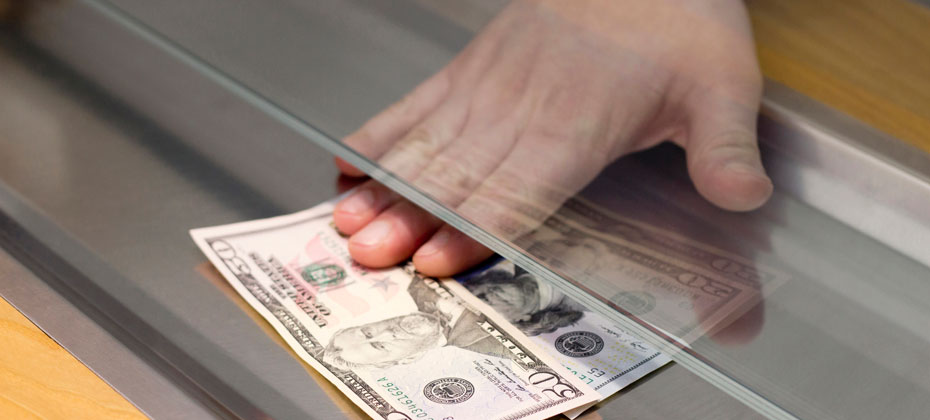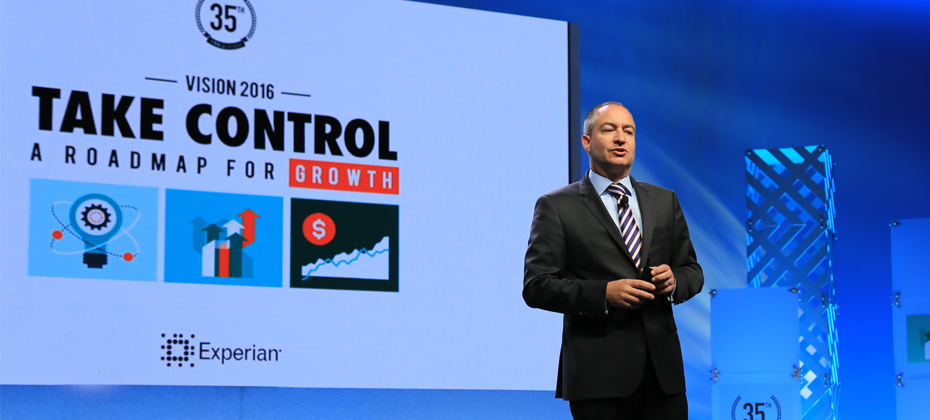Credit Lending

According to a national survey by Experian, college students may be receiving their degrees, but their financial management knowledge still needs some schooling. The survey reveals some troubling data about recent graduates: Average student loan debt is $22,813 31% have maxed out a credit card 39% have accepted credit card terms and conditions without reading them Learning to manage debt and finances properly is key to young adults’ future financial success. Since students aren’t receiving credit and debt management education in college, they need to educate themselves proactively. Credit education resources are available on Experian's Website. >> Experian College Graduate Survey Report

Experian cited in Mobile Fraud Management Solutions report from Forrester as having the most capabilities and one of the highest estimated revenues in total fraud management

Experian consultant offers his recap from attending a half-day event hosted at The White House called the “FinTech Summit” largely focused on how government agencies can tap into the innovation, in which new firms are offering small-business owners and consumers faster forms of loans and digital payments. Federal regulators have been studying the industry to determine how it can be regulated while still encouraging innovation.

Part four in our series on Insights from Vision 2016 fraud and identity track It was a true honor to present alongside Experian fraud consultant Chris Danese and Barbara Simcox of Turnkey Risk Solutions in the synthetic and first-party fraud session at Vision 2016. Chris and Barbara, two individuals who have been fighting fraud for more than 25 years, kicked off the session with their definition of first-party versus third-party fraud trends and shared an actual case study of a first-party fraud scheme. The combination of the qualitative case study overlaid with quantitative data mining and link analysis debunked many myths surrounding the identification of first-party fraud and emphasized best practices for confidently differentiating first-party, first-pay-default and synthetic fraud schemes. Following these two passionate fraud fighters was a bit intimidating, but I was excited to discuss the different attributes included in first-party fraud models and how they can be impacted by the types of data going into the specific model. There were two big “takeaways” from this session for me and many others in the room. First, it is essential to use the correct analytical tools to find and manage true first-party fraud risk successfully. Using a credit score to identify true fraud risk categorically underperforms. BustOut ScoreSM or other fraud risk scores have a much higher ability to assess true fraud risk. Second is the need to for a uniform first-party fraud bust-out definition so information can be better shared. By the end of the session, I was struck by how much diversity there is among institutions and their approach to combating fraud. From capturing losses to working cases, the approaches were as unique as the individuals in attendance This session was both educational and inspirational. I am optimistic about the future and look forward to seeing how our clients continue to fight first-party fraud.

On June 2, the Consumer Financial Protection Bureau (CFPB) proposed a rule aimed at “payday lending” that will apply to virtually all lenders, with request for comments by Sept. 14. Here is a summary of the basic provisions of the proposed rule. However, with comments, the proposal is more than 1,300 pages in length, and the proposed rule and examples are more than 200 pages long. It is necessary to review the details of the proposed rule to understand its potential impact on your products and processes fully. You may wish to review your current and future offerings with your institution’s counsel and compliance officer to determine the potential impact if major provisions of this proposed rule are finalized by the CFPB. Coverage The proposal generally would cover two categories of loans. First, the proposal generally would cover loans with a term of 45 days or less. Second, the proposal generally would cover loans with a term greater than 45 days, provided that they have an all-in annual percentage rate greater than 36 percent and either are repaid directly from the consumer’s account or income or are secured by the consumer’s vehicle. Ability to repay For both categories of covered loans, the proposal would identify it as an abusive and unfair practice for a lender to make a covered loan without reasonably determining that the consumer has the ability to repay the loan. Or if the lender does not determine if the consumer can make payments due, as well as meet major financial obligations and basic living expenses during and for 30 days after repayment. Lenders would be required to verify the amount of income that a consumer receives, after taxes, from employment, government benefits or other sources. In addition, lenders would be required to check a consumer’s credit report to verify the amount of outstanding loans and required payments. “Safe Harbor” The proposed rule would provide lenders with options to make covered loans without satisfying the ability-to-repay and payment notice requirements, if those loans meet certain conditions. The first option would be offering loans that generally meet the parameters of the National Credit Union Administration “payday alternative loans” program, where interest rates are capped at 28 percent and the application fee is no more than $20. The other option would be offering loans that are payable in roughly equal payments with terms not to exceed two years and with an all-in cost of 36 percent or less, not including a reasonable origination fee, so long as the lender’s projected default rate on these loans is 5 percent or less. The lender would have to refund the origination fees any year that the default rate exceeds 5 percent. Lenders would be limited as to how many of either type of loan they could make per consumer per year. Outstanding loans The proposal also would impose certain restrictions on making covered loans when a consumer has — or recently had — certain outstanding loans. These provisions are extensive and differ between short- and long-term loans. For example: Payday and single-payment auto title: If a borrower seeks to roll over a loan or returns within 30 days after paying off a previous short-term debt, the lender would be restricted from offering a similar loan. Lenders could only offer a similar short-term loan if a borrower demonstrated that their financial situation during the term of the new loan would be materially improved relative to what it was since the prior loan was made. The same test would apply if the consumer sought a third loan. Even if a borrower’s finances improved enough for a lender to justify making a second and third loan, loans would be capped at three in succession followed by a mandatory 30-day cooling-off period. High-cost installment loans: For consumers struggling to make payments under either a payday installment or auto title installment loan, lenders could not refinance the loan into a loan with similar payments. This is unless a borrower demonstrated that their financial situation during the term of the new loan would be materially improved relative to what it was during the prior 30 days. The lender could offer to refinance if that would result in substantially smaller payments or would substantially lower the total cost of the consumer’s credit. Payments Furthermore, it would be defined as an unfair and abusive practice to attempt to withdraw payment from a consumer’s account for a covered loan after two consecutive payment attempts have failed, unless the lender obtains the consumer’s new and specific authorization to make further withdrawals from the account. The proposal would require lenders to provide certain notices to the consumer before attempting to withdraw payment for a covered loan from the consumer’s account unless exempt under one of the “safe harbor” options. Registered information systems Finally, the proposed rule would require lenders to use credit reporting systems to report and obtain information about loans made under the full-payment test or the principal payoff option. These systems would be considered consumer reporting companies, subject to applicable federal laws and registered with the CFPB. Lenders would be required to report basic loan information and updates to that information. The proposed regulation may be found here.

According to the most recent State of the Automotive Finance Market report, the total balance of open automotive loans increased 11.1% in Q1 2016, reaching $1.005 trillion — up from $905 billion in Q1 2015. This is the first time on record that automotive loans have passed the $1 trillion mark. The report also revealed that subprime loan volumes experienced double-digit growth and overall delinquencies remained low. With more consumers relying on financing, lenders should monitor credit and delinquency trends in order to adjust strategies accordingly. >>Webinar: Hear about the latest consumer credit trends

As net interest margins tighten and commercial real estate concentrations begin to slowly creep back to 2008 levels, financial institutions should consider looking to their branch networks to drive earnings. Why wouldn’t you, right? The good news is branch networks can embrace that challenge by simply using some of the tools they already have access to – most notably the credit report. Credit reports are generally seen as a tool to assist financial institutions in assessing credit risk. However, if used properly, credit reports can provide a wealth of insight on selling opportunities as well. Typically when a customer’s credit report is pulled, the personal banker or customer service representative is primarily focused on whether or not a loan application is approved based on the institution’s approval parameters. Instead, what if a lender elected to view this customer interaction as an opportunity to deepen the relationship? So, here are three ways to utilize credit reports to generate earnings through retail loan growth: 1. Opportunities to Consolidate Debt Looking for debt consolidation opportunities is probably the simplest way to mine for opportunities. For example: Personal Banker: “It looks like you also have a card credit with XYZ and ABC Bank. Based on your application, we can consolidate both of those balances into one and give you a lower interest rate.” Be specific. Tell the customer exactly how much money per month they would be able to save and the benefits of consolidation. Not to mention, debt consolidation often reduces a lender’s credit risk and enhances customer loyalty, so this is a win for the institution as well. 2. Opportunities to Provide Additional Credit Another method would be to “soft pull” a segment of your portfolio to identify customers who qualify for larger credit card balances or refinance opportunities. This strategy is best executed at the portfolio management level, as insight is needed on the bank risk appetite and concentration levels. Layering on a basic prescreen helps qualify and segment your prospect list according to your unique credit criteria. You can also expand the universe with an Experian extract list, identifying new consumers who might be open to new offers. 3. Find Hidden Opportunities Credit scoring models are not perfect. There are times when a person’s credit score does not reflect an applicant’s true risk profile. For example, a person who was temporarily out of work may have missed two to three payments during that period. A deeper scan of the credit report during underwriting may reveal an opportunity to lend to a person rebounding from financial difficulties not yet reflected by their credit score. For example, this individual may have missed two credit card payments but hasn’t missed a mortgage or car payment in 20 years. A score is just one dimension to the story, but trended insights can shine a light on who best to lend to in the future. Conclusion: With the proper tools and training, your retail team can get more out of the basic credit report and find additional opportunities to deepen customer relationships while maintaining your desired risk profile. The credit report can be a workhorse for your team, so why not leverage it for more business. Note: The information above outlines several uses for a credit report. Separate credit reports are required for each use with the intended permissible purpose. Ancin Cooley is principal with Synergy Bank Consulting, a national credit risk management and strategic planning firm. Synergy provides a rangeof risk management services to financial institutions, which include loan reviews, IT audits, internal audits, and regulatory compliance reviews. As principal, Ancin manages a growing portfolio of clients throughout the United States.

It’s more than mercury that will be up this summer. As temperatures climb, so do automotive sales, which often reach annual highs during the warmest months of the year. Fueled by pent-up demand coming out of the recession, historically low interest rates, and increased competition among both manufacturers and lenders, auto sales are continuing to be a bright spot in the U.S. economy. Summer sales spike According to recent research by Experian Automotive, 2015 sales of new non-luxury vehicles began rising in May and peaked in August at nearly 20 percent above the monthly average for the year. It is not surprising, given the number of notable manufacturer marketing campaigns that often air through the summer months, beginning with Memorial Day and running all the way through Labor Day weekend. The projection is that this trend will continue in 2016. Financing moves metal Financing continues to play an important role in facilitating new car sales. Experian research shows a consistent increase in the percentage of new vehicles sold with financing with the trend reaching a period high of 85.9 percent in Q4 2015, a 2.3 percent increase over the previous year. The increased financing, is due in part, to continued post-recession liquidity. As the economy has rebounded, lenders have re-emerged with attractive financing rates for buyers. In addition, captive lenders are continuing to support manufacturers with 0 percent subvention offers to increase sales. Total loan value is on the rise as well, reaching $29,551 in Q4 2015, a 4.1 percent increase over the previous year. Average MSRP is trending up too, but at a slower year-over-year rate of 3.6 percent. The slower growth in MSRP relative to total loan value is leading to increased loan-to-value ratios which reached 109.4 percent in Q4 2015. The increases in loan value and MSRP are putting pressure on monthly payment with average new vehicle payments reaching $493 per month on new loans in the fourth quarter. Seeking relief, consumers are turning to longer loan terms and leasing to maintain lower payments. As a result, average new vehicle loan terms ticked slightly higher to 67 months while lease penetration on new vehicles reached 28.9 percent, a 19 percent increase over the previous year. Leveraging the trends Timing is everything when it comes to auto lending. Direct mail remains an effective communication tool for lenders, but mass mailers without regard to response rates yield poor ROIs and put future campaigns in jeopardy. Targeting consumers who are most likely to be in the market at a point in time can increase response rates and improve overall campaign performance. Experian’s In the Market Model – Auto leverages the power of trended credit data to identify consumers that will be most receptive to an offer. By focusing on high-propensity consumers, lenders can conduct more marketing campaigns during the year with the same budget and achieve supercharged results. Context-based marketing allows lenders to tailor offers by leveraging insights on a consumer’s existing loans. Product offers can additionally be customized based on estimated interest rates, months remaining, or current loan balance on open auto loans. Targeted refinance offers can also be delivered to consumers with high interest rates or focus new-loan offers on consumers with minimal months or balance remaining on existing loans. Understanding current auto loans allows lenders to target offers that are relevant to their prospects and gain an advantage over the competition. Increases in loan-to-value (LTV) ratios at origination and longer loan terms are putting many consumers in deep negative equity positions. As a result, many consumers will not qualify for refinance offers without significant down payments leading to low underwriting conversion rates and poor customer experience. Lenders seeking to improve on these metrics should leverage Experian’s Auto Equity Model, which provides an estimate of the amount of equity a consumer has in their existing auto trades. Focusing refinance offers on consumers with negative equity, while suppressing those with deep negative positions, can help improve response rates while minimizing declines due to LTV requirements. Takeaways Lenders should be gearing up for the summer auto sales spike. Proactive strategies will allow savvy marketers to deploy capital and grow their portfolio by taking advantage of customer insight. Timing and context matter, and as auto sales trends reveal, now is the opportune time to optimize marketing efforts and capitalize on the season.

More home buyers and sellers tend to enter the market in the warmer months, making spring and summer a busy season for mortgage brokers and lenders seeking to close deals and work through the mounds of paperwork associated with a home purchase. In April, the number of existing homes sold shot up 4.9 percent year-over-year, to 471,000 purchases across the United States, according to a recent report from the National Association of Realtors®. And sales were up 11.9 percent in April from March. With the belief that mortgage rates will finally start to climb in the coming months, fence-sitters will likely make a move this summer in order to capitalize on attractive rates, creating a healthy home-buying season. On average, it takes 45 days to close a home loan, and anyone going through that process will admit the process can cause stress, anxiety and uncertainty. In fact, a recent study ranked buying a home as the No. 1 most stressful experiences in modern life with 69 percent calling it “stressful.” There are so many tollgates along the journey. Will the consumer qualify for a mortgage? Will the home appraise at the right price? Does the home pass inspection? Are there contingencies that can suddenly halt the sale? Will the seller or buyer get cold feet and send weeks of work down the drain? Of course there are many factors people can’t control as they seek to land their next home, but there are ways both the consumer and lender can work together to smooth out the process and endure the average 45-day closing period. Getting pre-approved for a home loan is obviously the ideal, with consumers understanding their credit score, existing financial obligations and the type of loan they can qualify for, as well as money required at closing. Increasingly, borrowers know the impact credit can have on their home-buying experience. A 2016 Experian study revealed: 93 percent of consumers reported “one’s credit score is important in purchasing a home” 48 percent stated “they are working to improve their credit to qualify for a better home rate” 34 percent of future first-time buyers say “their credit might hurt their ability to purchase a home” In this competitive market, low fees and interest rates drive consumers’ business. However, credit circumstances such as high debt-to-income ratios, too many open trades, or high balances may inhibit lenders or mortgage brokers from offering favorable terms, or even approving a loan altogether. In these scenarios, consumers may qualify for better loan terms simply by paying down debt. Lenders or brokers can assist their customer in rapidly refreshing, re-scoring, or correcting information on their credit report in one to two business days. This step can obviously help consumers, but also benefit lenders by retaining credit applicants before they pursue competitive offerings. Occasionally errors may pop up on a consumer’s credit report – an outdated trade line or inaccuracy – which can also impact the home-buying process. Consumers have the ability to file a dispute with the credit bureaus or their lender directly, and those disputes must be addressed within 30 days. However, if a loan process is already underway, mortgage brokers and lenders can help expedite the process by using a product like Experian’s Express Request™ to facilitate dispute resolution in 48 hours. Quickly addressing an inaccuracy benefits the home buyer, but also the lender who is likely working to close a number of loans during the busy spring and summer months. Without a doubt, the documentation process surrounding a home purchase is intense, but if all parties come to the table quickly with the requested items and verification, the process can be smoother. And then the stress can turn to scheduling moving vans and packing …

A recent study shows that small-business credit conditions remained relatively unchanged in Q1 2016, as delinquency and bankruptcy rates held steady at low levels. Much of the slight decrease in delinquencies was driven by fewer small businesses falling within the 61 to 90 and 91+ days past-due categories. Gaining deeper insight into the health of small businesses is important for both lenders and small-business owners. Experian® provides market-leading tools that enable small businesses to find new customers, process new applications, manage customer relationships and collect on delinquent accounts. >> Q1 2016 report

Part 2 in our series on Insights from the Vision 2016 fraud and identity track With the growing number of data breach incidents taking place the stolen data from those attacks is being used to carry out social engineering attacks used to commit call center fraud. A recent study stated that global call center fraud has increased more than 45% in the last three years as fraudsters use social engineering to steal data and turn profits. The same report found that criminals might make up to 5 calls to a center, pretending to be the victim, before completing a fraudulent transaction. The importance of strong call center authentication procedures is greater than ever. At the 35th annual Vision Conference, Bobbie Paul from Experian’s Global Consulting Practice, Stefan Schubert from JPMorgan Chase and I led a session about call center authentication. After introductions and a discussion about existing call center identity authentication techniques, Stefan took the podium and provided an excellent overview of how his company approaches call center authentication. He made an interesting point — despite introducing friction into his process, he was not of the opinion that knowledge-based authentication (KBA) was going away any time soon because of how deeply it is embedded into their processes and its applicability to most consumers. He also called out the importance of reviewing KBA configurations regularly to adjust which questions are being asked and the positive implication to deterring fraudsters. Bobbie followed Stefan to discuss emerging call center authentication technologies, including a new take on an old tool — document imaging. She also discussed the notion of phone printing, which does not specifically evaluate the voice on the phone, but looks at the characteristics of the call itself, including the type of phone being used and the environment from which the call is being made. One of the highlights of the session was the interaction with the audience — including a demonstration of how, with a little distraction, it was easy to walk away with an audience member’s phone, how a fraudster could access and compromise a phone and how a gummy bear could be used to defeat fingerprint biometrics. What I, and many others, took away from this is that even with newer fraud detection tools available, incorporating tried-and-true methods like KBA is still an important step into a holistic fraud detection strategy.

According to a national survey by Experian, one in five college grads give their school an “F” in credit education. Additional survey highlights: 69% will have student loan debt after graduation 71% did not learn about credit and debt management in college 55% feel like they are “going it alone” when it comes to their finances 72% express concern about paying off their debt Credit is a skill — one that can be developed through the right education. The Experian Credit Education blog has useful information to help college grads learn the basics of credit and how they can improve their credit score. College Graduate Survey Report

James W. Paulsen, Chief Investment Strategist for Wells Capital Management, kicked off the second day of Experian’s Vision 2016, sharing his perspective on the state of the economy and what the future holds for consumers and businesses alike. Paulsen joked this has been “the most successful, disappointing recovery we’ve ever had.” While media and lenders project fear for a coming recession, Paulsen stated it is important to note we are in the 8th year of recovery in the U.S., the third longest in U.S. history, with all signs pointing to this recovery extending for years to come. Based on his indicators – leverage, restored household strength, housing, capital spending and better global growth – there is still capacity to grow. He places recession risk at 20 to 25 percent – and only quotes those numbers due the length of the recovery thus far. “What is the fascination with crisis policies when there is no crisis,” asks Paulsen. “I think we have a good chance of being in the longest recovery in U.S. history.” Other noteworthy topics of the day: Fraud prevention Fraud prevention continues to be a hot topic at this year’s conference. Whether it’s looking at current fraud challenges, such as call-center fraud, or looking to future-proof an organization’s fraud prevention techniques, the need for flexible and innovative strategies is clear. With fraudsters being quick, and regularly ahead of the technology fighting them, the need to easily implement new tools is fundamental for you to protect your businesses and customers. More on Regulatory The Military Lending Act has been enhanced over the past year to strengthen protections for military consumers, and lenders must be ready to meet updated regulations by fall 2016. With 1.46 million active personnel in the U.S., all lenders are working to update processes and documentation associated with how they serve this audience. Alternative Data What is it? How can it be used? And most importantly, can this data predict a consumer’s credit worthiness? Experian is an advocate for getting more entities to report different types of credit data including utility payments, mobile phone data, rental payments and cable payments. Additionally, alternative data can be sourced from prepaid data, liquid assets, full file public records, DDA data, bill payment, check cashing, education data, payroll data and subscription data. Collectively, lenders desire to assess someone’s stability, ability to pay and willingness to repay. If alternative data can answer those questions, it should be considered in order to score more of the U.S. population. Financial Health The Center for Financial Services Innovation revealed insights into the state of American’s financial health. According to a study they conducted, 57 percent of Americans are not financially healthy, which equates to about 138 million people. As they continue to place more metrics around defining financial health, the center has landed on four components: how people plan, spend, save and borrow. And if you think income is a primary factor, think again. One-third of Americans making more than $60k a year are not healthy, while one-third making less than $60k a year are healthy. --- Final Vision 2016 breakouts, as well as a keynote from entertainer Jay Leno, will be delivered on Wednesday.

It’s impossible to capture all of the insights and learnings of 36 breakout sessions and several keynote addresses in one post, but let’s summarize a few of the highlights from the first day of Vision 2016. 1. Who better to speak about the state of our country, specifically some of the threats we are facing than Leon Panetta, former Secretary of Defense and Director of the CIA. While we are at a critical crossroads in the United States, there is room for optimism and his hope that we can be an America in Renaissance. 2. Alex Lintner, Experian President of Consumer Information Services, conveyed how the consumer world has evolved, in large part due to technology: 67 percent of consumers made purchases across multiple channels in the last six months. More than 88M U.S. consumers use their smartphone to do some form of banking. 68 percent of Millennials believe within five years the way we access money will be totally different. 3. Peter Renton of Lend Academy spoke on the future of Online Marketplace Lending, revealing: Banks are recognizing that this industry provides them with a great opportunity and many are partnering with Online Marketplace Lenders to enter the space. Millennials are not the largest consumers in this space today, but they will be in the future. Sustained growth will be key for this industry. The largest platforms have everything they need in place to endure – even through an economic downturn.In other words, Online Marketplace Lenders are here to stay. 4. Tom King, Experian’s Chief Information Security Officer, addressed the crowds on how the world of information security is growing increasingly complex. There are 1.9 million records compromised every day, and sadly that number is expected to rise. What can businesses do? “We need to make it easier to make the bad guys go somewhere else,” says King. 5. Look at how the housing market has changed from just a few years ago: Inventory continues to be extraordinarily lean. Why? New home building continues to run at recession levels. And, 8.5 percent of homeowners are still underwater on their mortgage, preventing them from placing it on the market. In the world of single-family home originations, 2016 projections show that there will be more purchases, less refinancing and less volume. We may see further growth in HELOC’s. With a dwindling number of mortgages benefiting from refinancing, and with rising interest rates, a HELOC may potentially be the cheapest and easiest way to tap equity. 6. As organizations balance business needs with increasing fraud threats, the important thing to remember is that the customer experience will trump everything else. Top fraud threats in 2015 included: Card Not Present (CNP) First Party Fraud/Synthetic ID Application Fraud Mobile Payment/Deposit Fraud Cross-Channel FraudSo what do the experts believe is essential to fraud prevention in the future? Big Data with smart analytics. 7. The need for Identity Relationship Management can be seen by the dichotomy of “99 percent of companies think having a clear picture of their customers is important for their business; yet only 24 percent actually think they achieve this ideal.” Connecting identities throughout the customer lifecycle is critical to bridging this gap. 8. New technologies continue to bring new challenges to fraud prevention. We’ve seen that post-EMV fraud is moving “upstream” as fraudsters: Apply for new credit cards using stolen ID’s. Provision stolen cards into mobile wallet. Gain access to accounts to make purchases.Then, fraudsters are open to use these new cards everywhere. 9. Several speakers addressed the ever-changing regulatory environment. The Telephone Consumer Protection Act (TCPA) litigation is up 30 percent since the last year. Regulators are increasingly taking notice of Online Marketplace Lenders. It’s critical to consider regulatory requirements when building risk models and implementing business policies. 10. Hispanics and Millennials are a force to be reckoned with, so pay attention: Millennials will be 81 million strong by 2036, and Hispanics are projected to be 133 million strong by 2050. Significant factors for home purchase likelihood for both groups include VantageScore® credit score, age, student debt, credit card debt, auto loans, income, marital status and housing prices. More great insights from Vision coming your way tomorrow!

According to a recent Experian survey, the majority of newlyweds say financial responsibility is a key quality in a spouse. Yet many neglect to discuss finances with their partner before marriage. Other factors unknown to newlyweds include: Their spouse’s credit score (40%) Their spouse’s annual income (25%) Their spouse’s long-term financial goals (31%) The amount of their spouse’s student loan debt (31%) As newlyweds face a blending of finances for a promising tomorrow, lenders can help by providing personalized credit education to start building strong relationships with these potentially loyal, creditworthy customers. Survey Results: Newlyweds and Credit